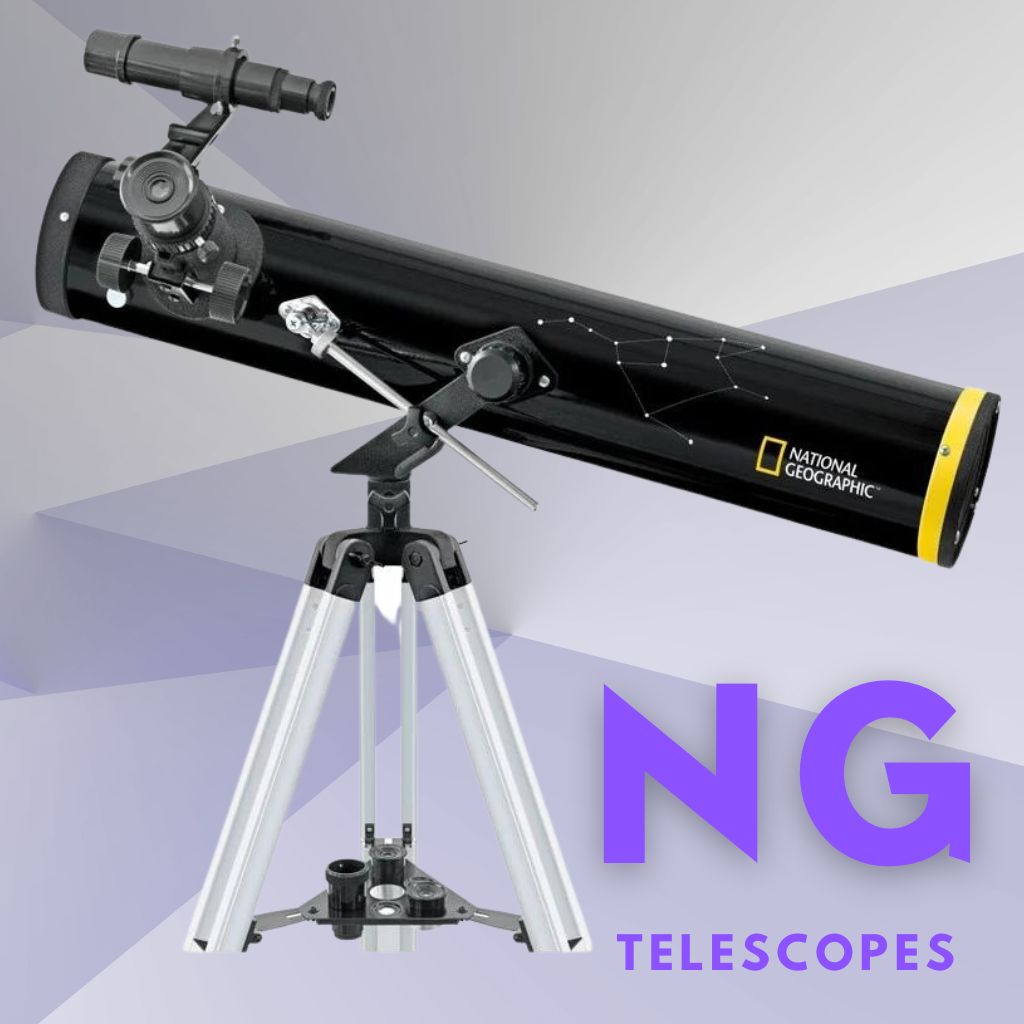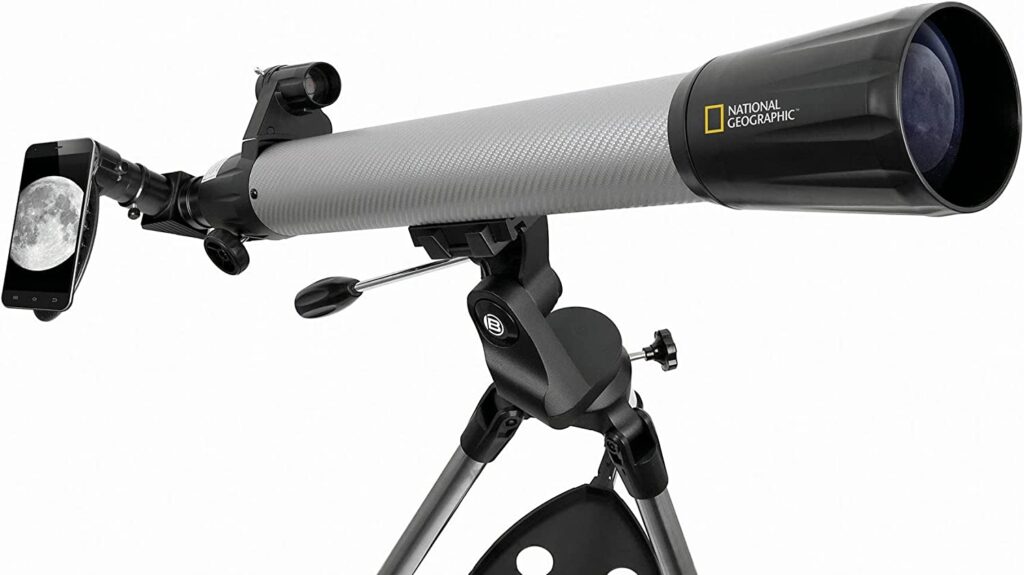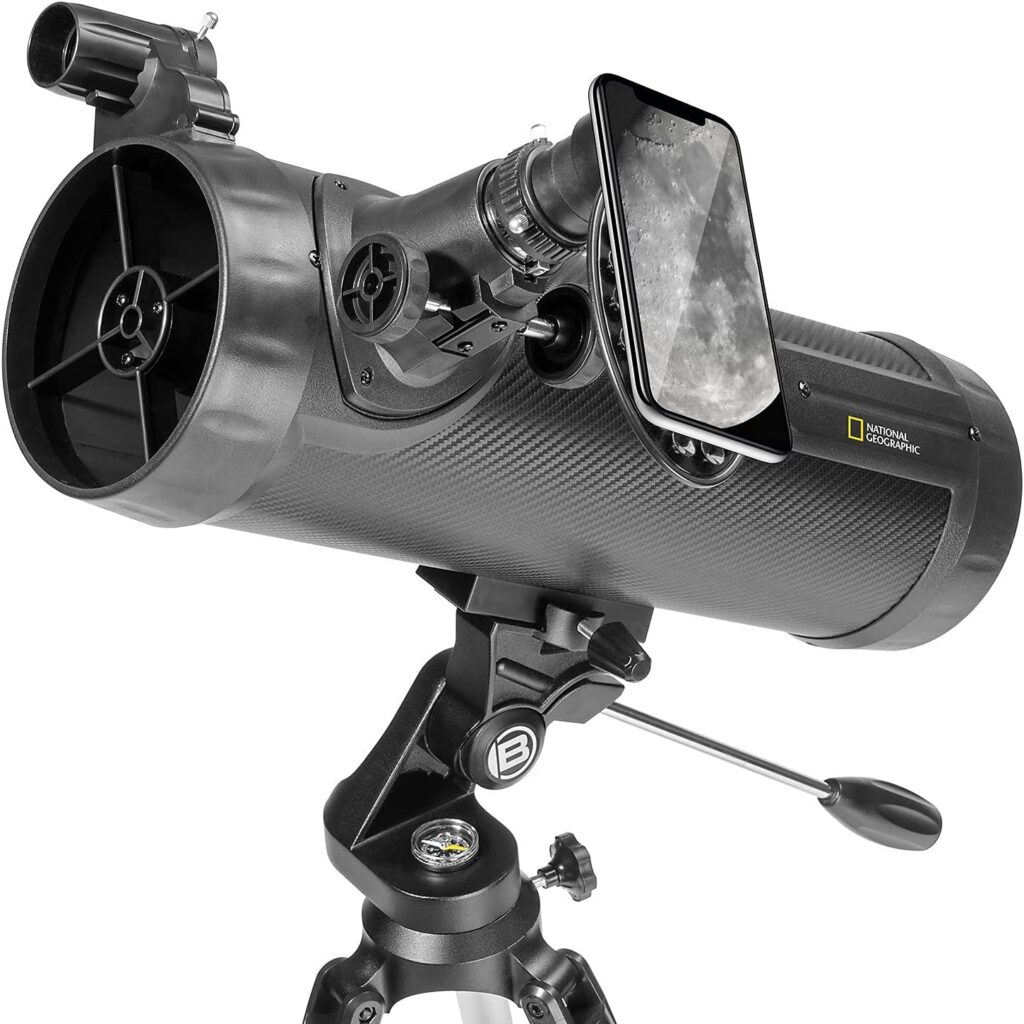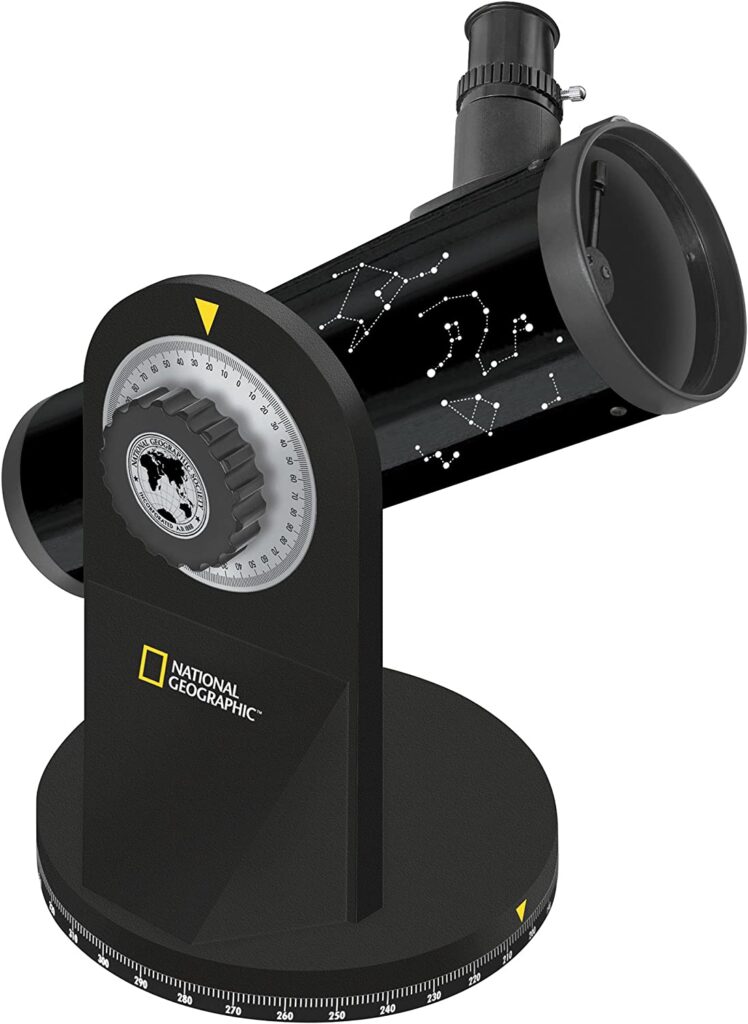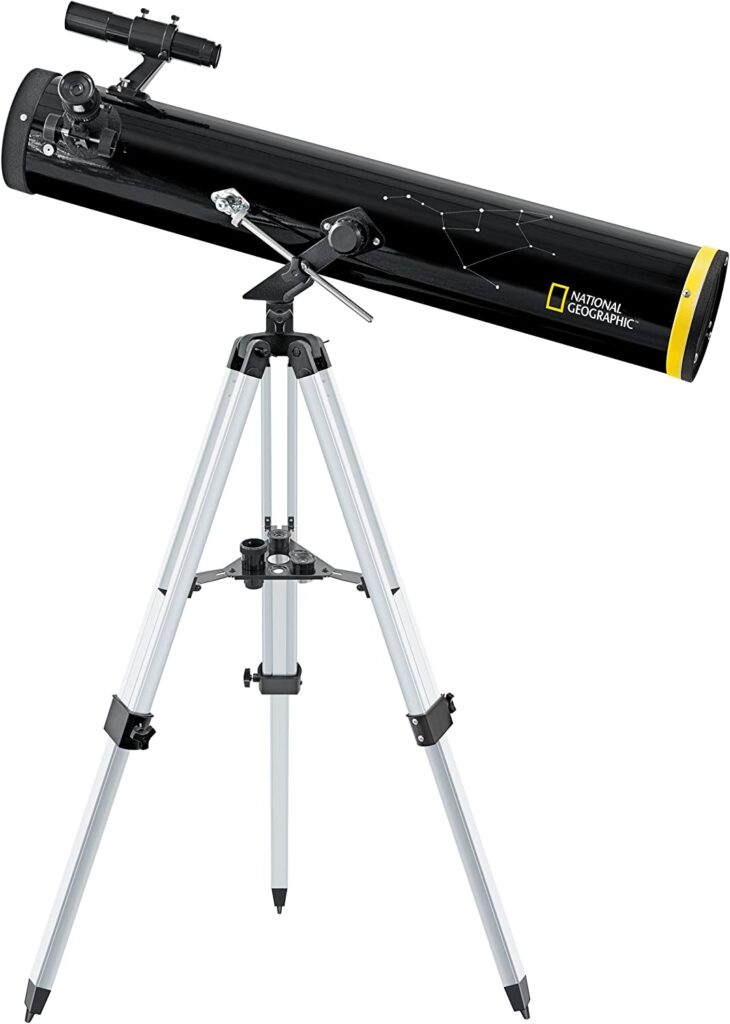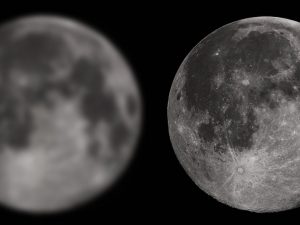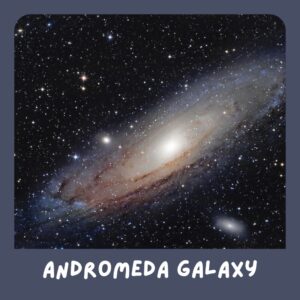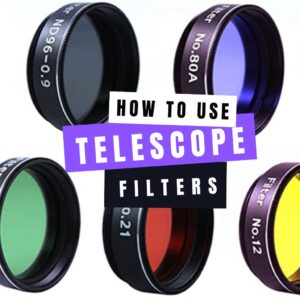This site contains affiliate links to products. I may receive a commission for purchases made through these links.
National Geographic telescopes come with high-quality optics and are very easy to use. They have preassembled special mounts and accessories like eyepieces and filters. Developed by the German company Bresser, these telescopes have an affordable price, making them perfect for all users.
There is a wide variety of these telescopes you can choose from. Each comes with a different purpose, so it’s best to research your options and choose a suitable one. For instance, the reflector telescope should be your choice to peer deep into the cosmos and discover deep-sky objects like nebulae and far-away galaxies. The refractor telescope is best for viewing nearby objects like the moon and stars.
In this article, we’ll be exploring other features of these stunning telescopes and what models are best suited for different astronomy enthusiasts.
National Geographic kid’s telescopes
National Geographic offers a range of telescopes that are specifically designed for kids, providing an exciting way for children to explore the night sky and learn about astronomy.
National Geographic kids telescopes are designed to be durable and easy to use, with features such as intuitive focus knobs and simplified alignment procedures. They are also often accompanied by educational materials and guides, allowing kids to learn about the objects they are observing and gain a deeper appreciation of astronomy.
Read also: Best telescopes for kids
National Geographic 70mm telescope
National Geographic offers three main variations of the 70mm Telescope: the standard 70mm model, the 70mm computerized telescope, and the 70mm – 80-40071CF model with an 80mm aperture.
Other National Geographic telescopes worth considering
Whether you’re interested in observing the moon and planets or deep-sky objects like galaxies and nebulae, National Geographic telescopes can help you see the universe in a whole new way!
Features of National Geographic telescopes
National Geographic has held a firm place in the history of science since 1888. Its vast history has translated into manufacturing some of the most popular and feature-rich telescopes of all time.
The features included are also common to high-quality telescopes that collectively impact each telescope’s light-gathering ability, the field of view, and magnification.
This section will discuss everything you need to know about these telescope features and what factors can improve your image quality.
Aperture size
The first and most important factor is the aperture size. The primary duty of a telescope is to capture light. A larger aperture means more light at any magnification, producing better image resolution.
These telescopes come in various aperture sizes suitable for all astronomy viewers.
Focal length
The focal length is the distance measured in mm from the lens to the focal point. As a rule of thumb, the greater the focal length, the more magnification power the Telescope will possess, and the image will be larger with a small field of view.
For instance, National Geographic’s 76/350 Compact Telescope features a focal length of 350mm. This gives it a wide field of view but a lower magnification power when compared to other telescopes that have longer focal lengths.
Focal ratio
The ratio you get from dividing the focal length by the aperture is known as the focal ratio. It’s also referred to as the speed of a telescope’s optics. The number is usually written in the format: f-number.
For instance, a National Geographic telescope with a focal ratio of f/13.8 will allow for higher magnification and detailed images of distant objects like Saturn’s rings.
Mount type
Telescopes are super crucial for controlling the Telescope’s movement. You can choose from several mount types, including the Altazimuth mount, the Equatorial mount, the Dobsonian mount, and more.
Telescopes from National Geographic also offer different mount types. You can choose a simple altazimuth mount for observing nearby celestial objects or go with an advanced equatorial mount that helps track celestial objects precisely.
The National Geographic 60/700 AZ Refractor Telescope sports an altazimuth mount, which is very easy to set up and use for casual observation.
Optical design
The optical design should also consider the aberrations to get the desired result of the object you’re observing. The design shows what the Telescope is built for.
Generally, three main optical telescope designs are available: refractors, reflectors, and catadioptric.
The National Geographic telescopes come in different optical designs. A reflector telescope design with a primary mirror helps to provide clear details of celestial objects and the lunar terrain. It also helps you explore other features of the solar system.
Eyepiece type
When viewing deep-space objects, telescopes need different eyepiece types to help you view objects at different distances.
The National Geographic scopes come in different types. They play a huge role in clearing the final image of the object you are viewing and also impact the field of view of the Telescope.
Tripod material
Tripods play a crucial role in the stability of telescopes. You need a proper platform to set your Telescope and reduce unwanted vibrations and movements so your final image won’t be blurred.
Tripods help give an excellent base that you can adjust according to your requirements and optimal viewing position. Additionally, an adjustable tripod also makes it easier to transport telescopes because of their lightweight and easy-to-carry mechanism.
For example, the National Geographic RT70400-70mm Reflector Telescope has a panhandle mount that helps you view space objects easily and adjust different heights and angles.
Telescope weight
Carrying around heavy objects isn’t something you’d want. However, that’s a good thing about these telescopes. They come in different sizes and materials, often manufactured from aluminum or carbon fiber, bringing down the Telescope’s net weight.
Finder scope
If you’re a beginner, you must equip yourself to use a finder scope. This is a smaller-sized telescope placed on the main Telescope that helps you sight celestial objects first and then move the main Telescope to view the object more vividly.
National Geographic telescopes come with finder scopes available in different sizes and magnifications to help you explore the universe more easily.
Focus mechanism
You’d want to get a clear image of your favorite planet if you’ve located it. That’s where the focus mechanism helps. It helps to adjust the clarity and sharpness of the planet or celestial body you’re viewing.
Moreover, these telescopes come in a wide variety of great options that offer different focus mechanisms. These include the rack-and-pinion mechanism or the famous helical that provides added precision and control.
Collimation tools
Collimation is evenly aligning all optical elements in a telescope, making it a critical factor in achieving the best results.
If you have a poor collimation setting or use poor collimation tools, expect your image to be distorted, and you’ll end up with optical aberrations.
Most National Geographic telescopes come with collimation tools like the laser collimator or the Cheshire eyepiece that let you work on your optical alignment and make it as perfect as possible.
Barlow lens
The last feature is the Barlow lens, which helps toggle the magnification power of the Telescope and maximize it. You can always attach a Barlow lens to a National Geographic telescope to increase the magnification power or adjust it to your liking.
FAQs about National Geographic telescopes
If you’re interested in purchasing a National Geographic telescope or just curious about it, here are some frequently asked questions that may help you better understand these popular astronomy tools.
Who makes National Geographic telescopes?
National Geographic is a well-known brand that offers a wide range of products, including telescopes. National Geographic telescopes are made in collaboration with a company called Explore Scientific, which is a manufacturer of telescopes and other astronomical instruments.
Explore Scientific is a company that specializes in designing and producing high-quality telescopes and other astronomy equipment. They have been in the business for over a decade and have gained a reputation for producing excellent products.
National Geographic and Explore Scientific work together to design and produce telescopes that are specifically aimed at beginners and amateur astronomers. These telescopes are typically affordable and easy to use, making them an excellent choice for people who are just getting started with stargazing.
How to set up National Geographic telescopes?
The process for setting up a National Geographic telescope can vary depending on the model but typically involves assembling the tripod, attaching the mount and telescope tube, and aligning the finder scope.
It is important to carefully follow the instructions provided by National Geographic to ensure that your telescope is properly set up and calibrated. You may also want to familiarize yourself with the various components of the telescope and how to adjust them for optimal viewing.
If you are having trouble setting up your National Geographic telescope, you can try contacting their customer service for assistance. They may be able to provide additional guidance or troubleshoot any issues you are experiencing.
How do you focus a National Geographic telescope?
To focus a National Geographic telescope, you will need to adjust the position of the eyepiece until the image appears sharp and clear. Here are the steps to focus your telescope:
- Look through the eyepiece and adjust the focus knob until the image is as clear as possible.
- If the image is still blurry, adjust the focus knob in the opposite direction until the image comes into focus.
- Once the image is clear, you can fine-tune the focus by using the focus knob to make small adjustments.
It is important to note that focusing a telescope can be a delicate process, so it’s best to make small adjustments and take your time to avoid accidentally moving the telescope out of alignment.
Which National Geographic telescope is best for beginners?
National Geographic offers several telescopes that are great for beginners, but one of the most popular models is the National Geographic 70mm Telescope.
This telescope is a refractor telescope, which means it uses lenses to focus light and produce images. It also comes with a sturdy tripod, two eyepieces, and a red dot finder scope to help you locate objects in the sky. The 70mm aperture allows for decent light-gathering capabilities and the telescope can be used for both celestial and terrestrial viewing.
Overall, this telescope is a great option for beginners who want a good quality telescope at an affordable price.
You may also like: 21 Best Telescopes for Beginners (Ranked!)
Can you see planets with a National Geographic telescope?
You can see planets with a National Geographic telescope, depending on the model and specifications of the telescope. National Geographic telescopes are designed to be versatile and can be used to view a variety of celestial objects, including planets.
To get the best view of planets, it is important to have a telescope with a large aperture (the diameter of the telescope’s main lens or mirror) and good-quality optics. Some National Geographic telescopes have an aperture of 70mm, while others have larger apertures of 76mm or 90mm, which would provide better views of planets and other celestial objects.
It is important to note that the view of planets through a telescope can be affected by several factors, such as the planet’s position in the sky, atmospheric conditions, and light pollution.
However, with a good quality National Geographic telescope and favorable viewing conditions, you should be able to see planets such as Jupiter, Saturn, Mars, Venus, and even the rings of Saturn.
You may also like: 21 Best telescopes to see planets (Read this first!)
Why can’t I see anything through my National Geographic telescope?
There are several reasons why you may not be able to see anything through your National Geographic telescope:
- Incorrect assembly: It is possible that the telescope was not assembled correctly, which can cause alignment issues and prevent you from seeing anything through the eyepiece.
- Focusing issues: If you are not able to focus the telescope properly, you may not be able to see anything through the eyepiece. Make sure that you adjust the focus knob until the object you are trying to view appears clear and sharp.
- Poor viewing conditions: The quality of the viewing conditions can also affect what you are able to see through your telescope. Factors such as light pollution, atmospheric turbulence, and cloudy or hazy skies can all impact your ability to see objects clearly.
- Incorrect eyepiece: Make sure you are using the correct eyepiece for the object you are trying to view. Different eyepieces have different magnifications, and using the wrong one may make it difficult to see objects clearly.
If you are still having trouble seeing anything through your National Geographic telescope, it may be helpful to consult the user manual or contact the manufacturer’s customer service for additional troubleshooting advice.
Which astronomy app can be used in conjunction with a National Geographic telescope?
National Geographic does not have a specific app for their telescopes, but there are many astronomy apps available that can be used in conjunction with National Geographic telescopes to enhance the stargazing experience.
Some popular astronomy apps that you may find useful include:
- SkyView – an app that uses your phone’s camera to identify and locate stars, planets, and constellations in the night sky.
- Star Walk 2 – an interactive star chart that allows you to explore the night sky and learn more about celestial objects.
- Stellarium Mobile – a planetarium app that shows a realistic view of the sky and lets you explore the universe from your phone.
- Night Sky – an app that provides a live view of the night sky and offers information on stars, planets, and constellations.
These apps can be used to help you identify objects in the night sky, plan your observing sessions, and learn more about astronomy. They can be downloaded from the App Store or Google Play store for your mobile device.
Read also: The Best Stargazing App (for Smartphone & PC)
Where can I find instructions for National Geographic telescopes?
National Geographic provides instructions for each of their telescope models, which can typically be found in the product manual or on the National Geographic website.
If you have misplaced your instructions or are having trouble locating them, you can try contacting National Geographic customer service for assistance. They may be able to provide you with a digital copy of the instructions or walk you through the set-up and use of your telescope over the phone or via email.
National Geographic telescope reviews
Here are some reviews for National Geographic telescopes:
- “It is a good telescope for children as a starter. It was a wonderful birthday surprise for my grandson.”
- “Good For Beginners, would definitely recommend it as a gift.”
Visit the National Geographic page to find more reviews.
You may also like: National Geographic Telescope NT114CR Review
Takeaway: Explore the universe with National Geographic Telescopes
National Geographic has a long history in science and technology, so it’s no surprise that it also has excellent telescope options. These telescopes help discover the universe, its lunar details, the moon, and planetary features like Jupiter’s cloud belts.
You can enjoy beautiful views of the night sky without putting a considerable dip in your bank account.
All the telescopes have great features and user-friendly options, making them great for astronomy enthusiasts of all levels to observe celestial objects and even deep-sky objects.
You may also like:

